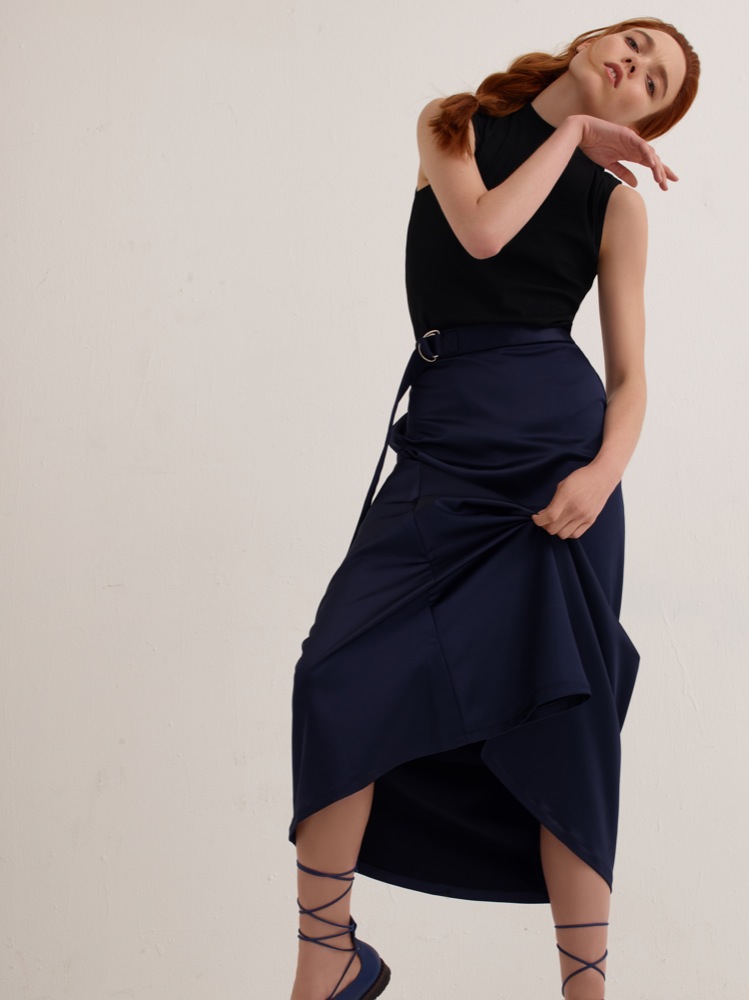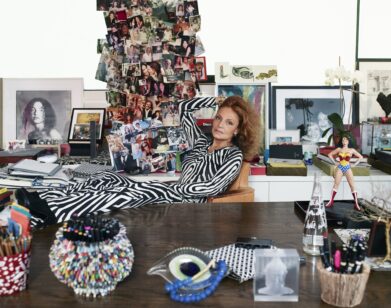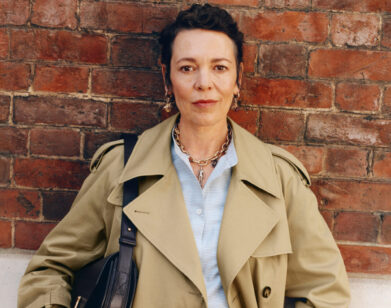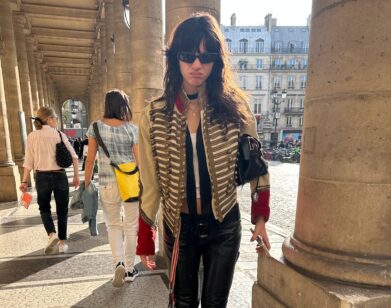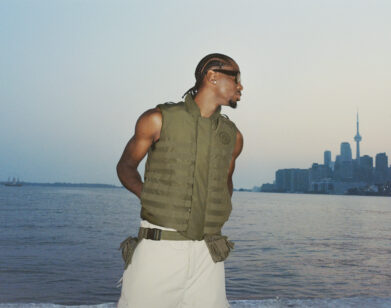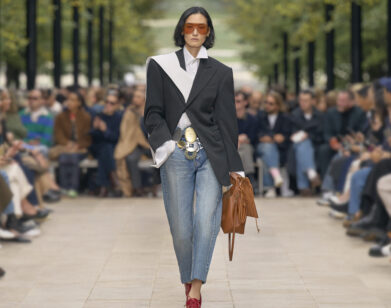Nomia Loves New York
BRILEY JONES AT TEN TON STUDIOS IN NEW YORK, MAY 2015. PHOTOS: HANS NEUMANN. STYLING: KATIE BURNETT. MAKEUP: CEDRIC JOLIVET AT SEE MANAGEMENT USING MAC COSMETICS. HAIR: KAYLA MICHELE AT STREETERS USING ORIBE. STYLING ASSISTANT: LAUREN PIVEN. RETOUCHING: TATIANA CHEBOTEROVA.
For her womenswear label Nomia, New York City-native Yara Flinn draws on all facets of her hometown, from uptown minimalism to downtown streetwear to contemporary visual artists. With crop tops, low-slung trousers, bomber jackets, and satin overalls, Nomia’s Fall/Winter 2015 collection was heavily inspired by Kim Gordon‘s short-lived X-Girl line. For Resort 2016, Flinn added a touch of sleek to her skater-chic with a long silk blazer fastened at the back with a silver keyring clasp.
Founded in 2009, Nomia has been growing steadily, with stockists including Barneys, Fivestory, Net-a-Porter, and The Webster. Here, Flinn, whose brother is the artists and model David Alexander Flinn, talks to model and new New Yorker Briley Jones. While the two have very different backgrounds (Jones grew up in rural Missouri and made her runway debut at Bottega Veneta’s F/W 2015 show), they both share a love for utilitarian, menswear-inspired fashion.
BRILEY JONES: I am a huge fan of your work.
YARA FLINN: Really? Oh that’s awesome. I am a huge fan of yours as well.
JONES: Oh thank you. It definitely suits my characteristics and everything.
FLINN: Kind of tom-boyish?
JONES: Very. Menswear for women is definitely my kind of thing—boyish converted to a girlish style.
FLINN: Exactly. I love that juxtaposition.
JONES: What made you decide to go that route?
FLINN: I grew up in New York City so I was always really influenced by streetwear and the way that young people styled themselves, especially in St. Marks Place or watching guys play basketball on West 4th Street. All of those things came together for me and formed into such a New York way of dressing. It’s definitely about comfort, but it’s a lot about personal style. I have always integrated utilitarian things into my wardrobe—whether it was military things or Dickies pants—and I wanted to find a way to update that for more of a mature kind of wear, but still have the sensibility of that.
JONES: Was there a specific figure or idol or person that you really drew from?
FLINN: I always really loved the Carolyn Bessette Kennedy style. She definitely was way more dressed up, but I think even if you look at pictures of her now from the late ’90s, she looked so modern and timeless. That really made me think about what kind of staples you could make for people—whether it’s just a long blazer you pair with jeans and make it look super chic but also effortless. I listened to a lot of rap growing up; I listened to a lot of different things. I had a minimal goth phase. I think it’s really important when you’re young to experiment with different looks and phases, and all of that eventually comes together and you create your own thing.
JONES: If you had to choose three power words that describe your collection, your aesthetic, what would they be?
FLINN: I guess I would say utilitarian, effortless, and minimal. There was a point when I was designing for someone else and I had this moment where I realized that if I didn’t really want to wear it all the time, how could I expect anyone else to? So I shifted my focus and even if it seems super obvious to me—”I just really want a huge parka”—[I think about] how can I make that different and make it my own thing. It’s not just about styling things [and] putting your own spin on it, but also not over-thinking it sometimes.
JONES: Definitely. Are there any other cities you’ve visited that have inspired you?
FLINN: My mom is from Brazil and my step-mom is from Italy, so I did actually travel a lot. I used to go to Italy sometimes in the summer and Brazil. I definitely think that had an effect on me, especially the Italian sensibility of wearing fine, very high quality things and restyling them and not having a new wardrobe every month. It was focus on design, and not just trends.
JONES: Something that’s ageless.
FLINN: Exactly. Everything except for shoulder pads. What about you, where did you grow up?
JONES: I grew up in Missouri out on a farm.
FLINN: Oh, wow. You’ve been coming to New York for a long time now?
JONES: No, I actually just moved here in the end of January.
FLINN: Do you like it?
JONES: Oh my gosh, yes. I feel like I’m at home. As soon as I got here I could finally dress the way I wanted. At home everybody wore their cowboy boots.
FLINN: That’s kind of amazing though. That’s a cool style right there. I want to see you in cowboy boots.
JONES: Oh boy. How do you think your style has evolved since you were in high school?
FLINN: In high school, there was a preppy raver thing that people had going on, which was The North Face jackets and khakis—really preppy for public school. For us it was so different, because no one went hiking or things like that; when we wore outerwear or really technical things it was for fashion. I love outerwear; it’s one of my favorite things to design. That stayed with me. I guess I evolved less than I thought I did. I don’t pluck my eyebrows as much now, I overdid that.
But you have to have fun, especially when you are growing up. The saddest thing for me is that [now] people want to imitate exactly what they see, to the point that they tell you exactly where to get everything. For me growing up, the fun part of seeing someone on the street and being like, “Oh my god that is so cool,” was running around trying to find things that were similar, not just saying, “I’m going to go online and buy every single thing they are wearing.”
JONES: What would you say your future goals are?
FLINN: I’ve been thinking about this lately because I’ve been doing this for a long time now, I feel really lucky to still be around and growing at this comfortable rate, but I really would love to eventually have a store or atelier and space where I could show art and furniture and different things, because those things—art and furniture and design—really influence me a lot. It would be awesome to have a space that was the whole world of what I do. I want to have lots of events there too.
FOR MORE ON NOMIA, VISIT THE LABEL’S WEBSITE.

